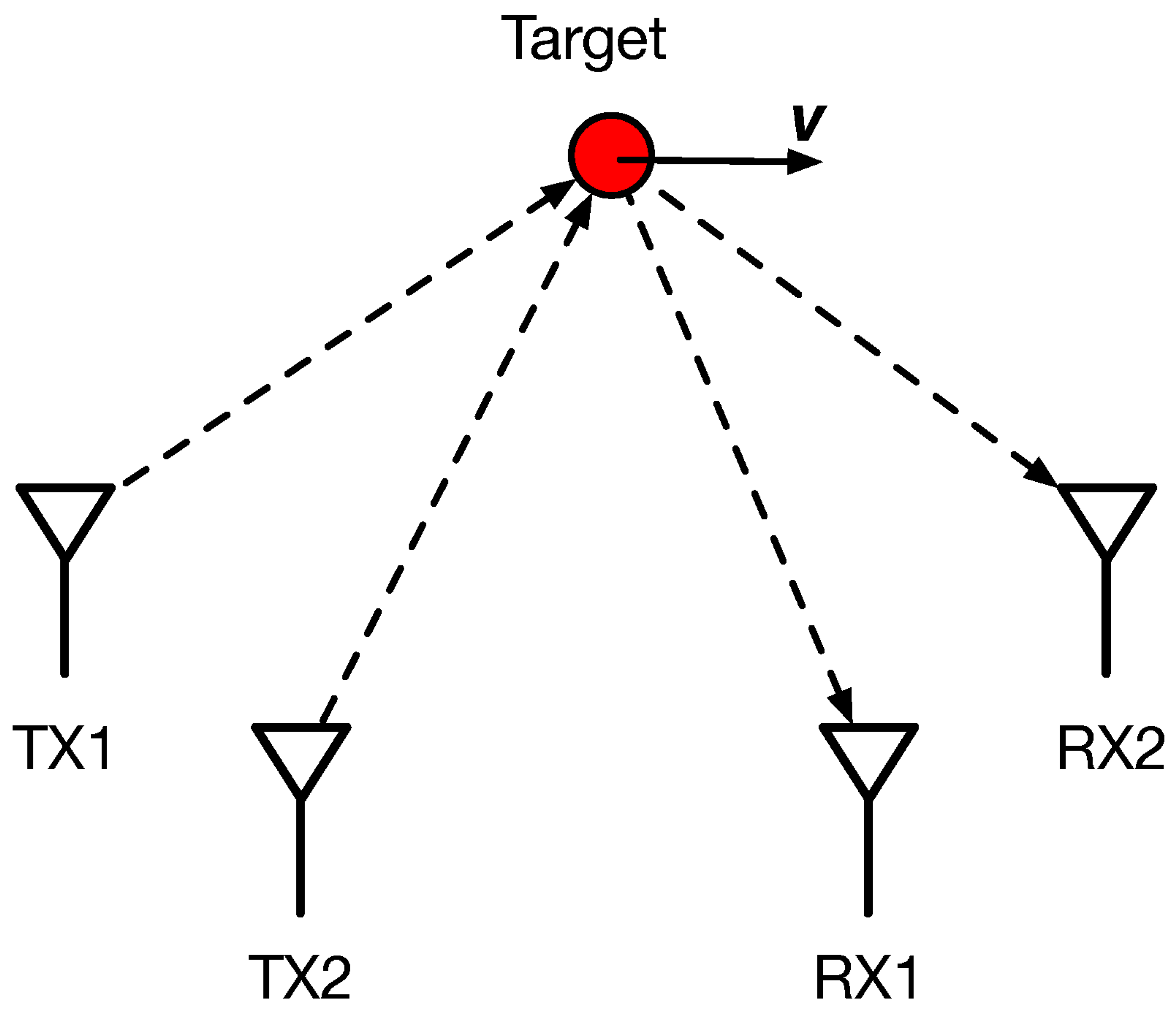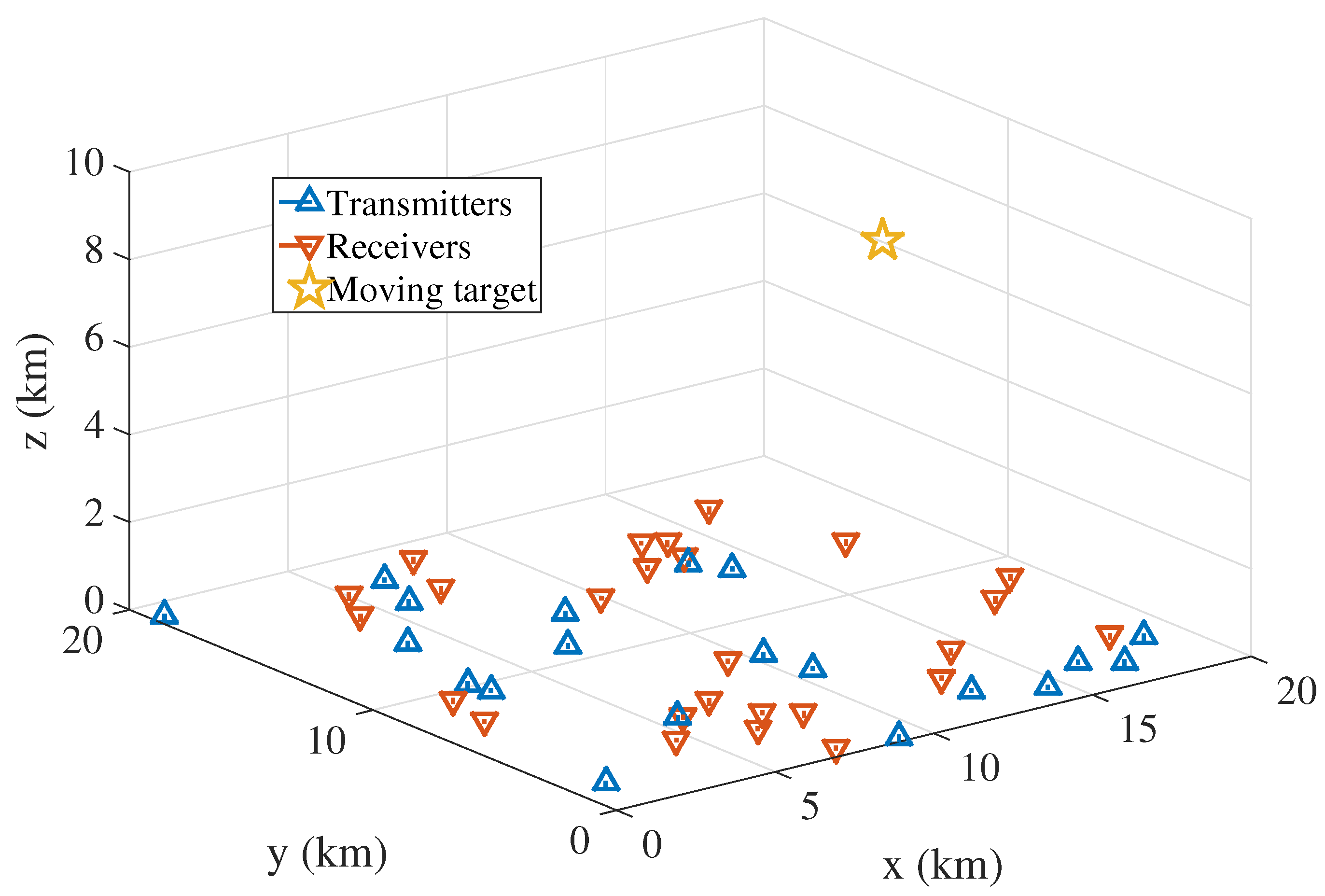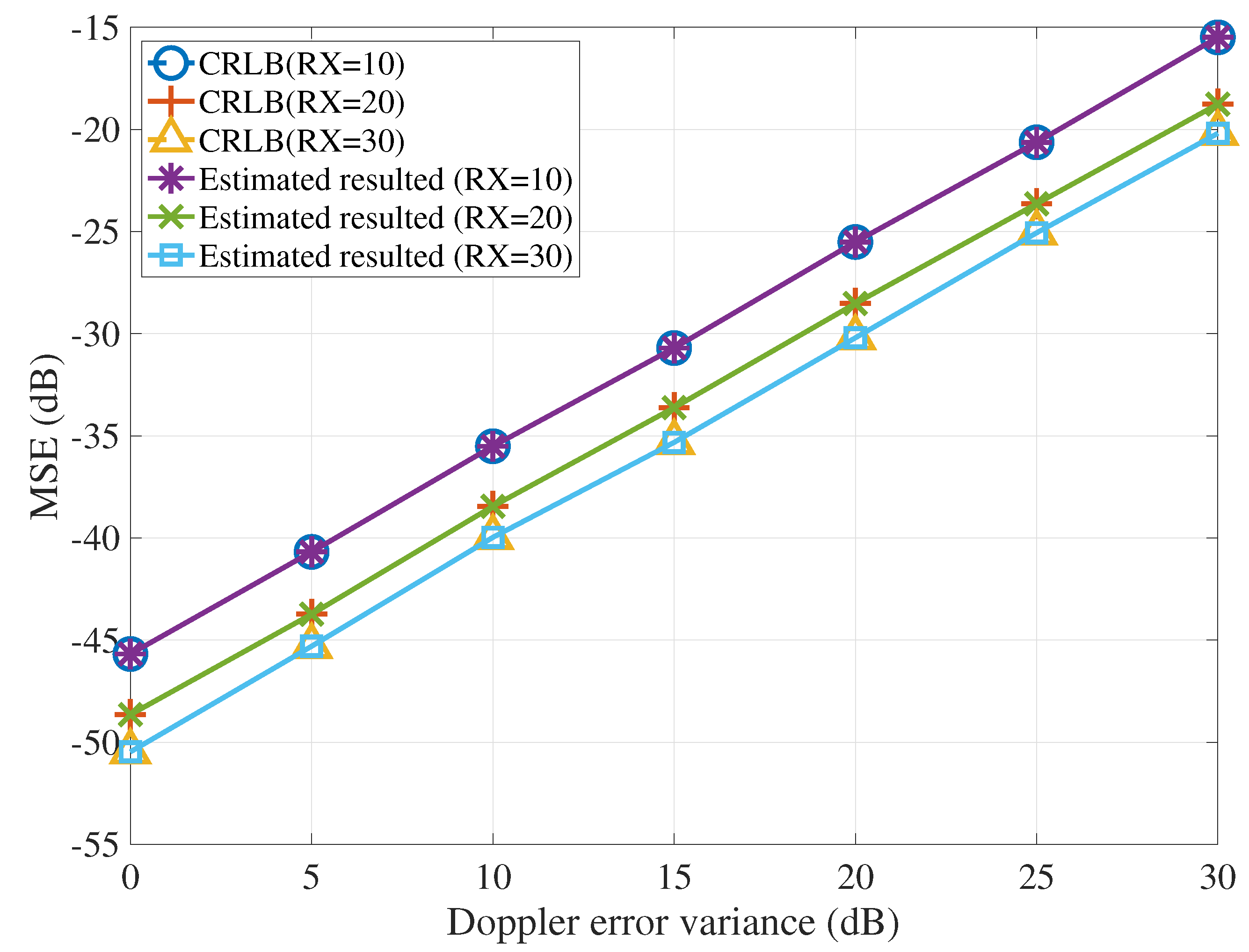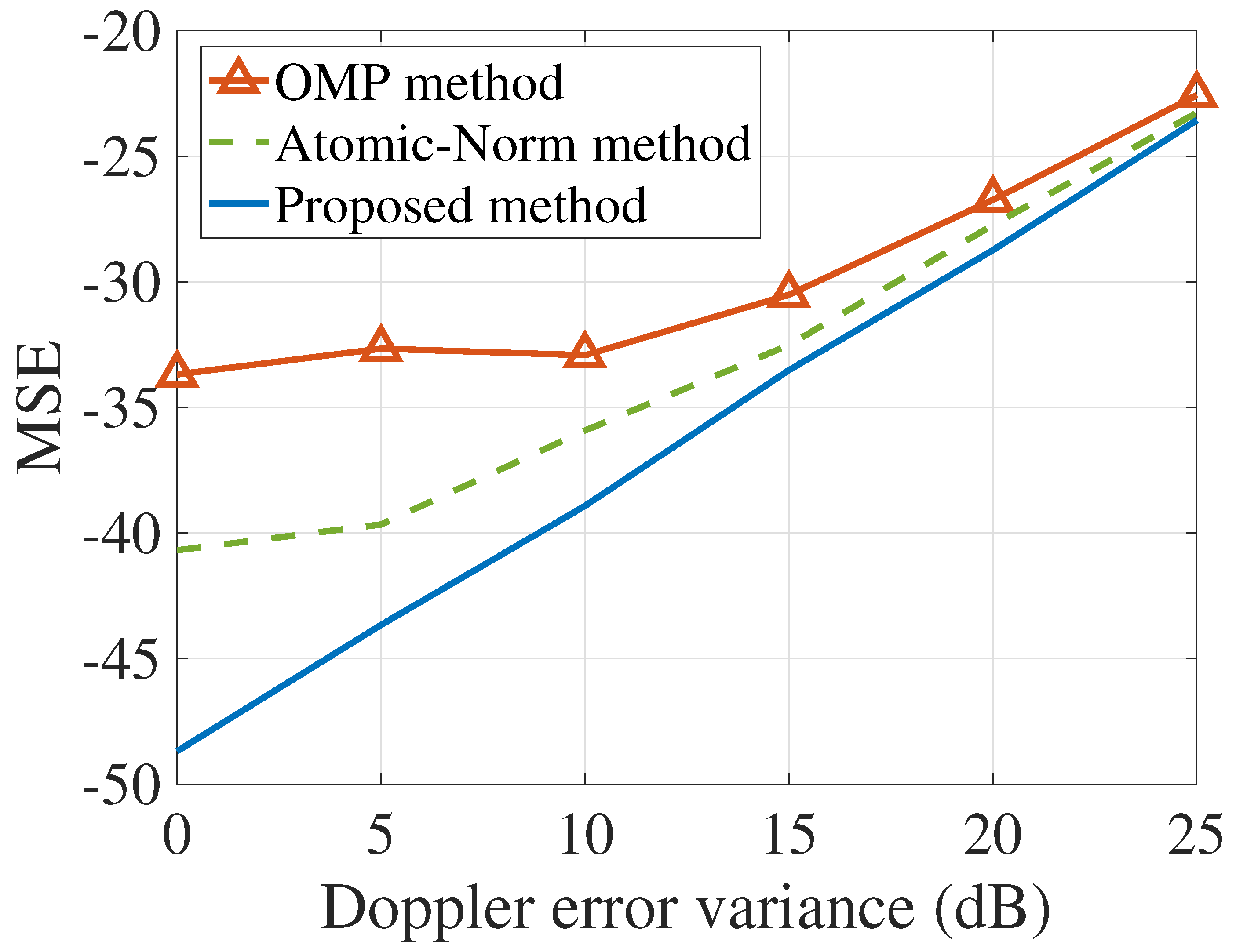Maximum Likelihood-Based Methods for Target Velocity Estimation with Distributed MIMO Radar
Abstract
:1. Introduction
2. System Model and Problem Formulation
3. Target Velocity Estimation
3.1. With the Target Position Information
3.2. Without the Target Position Information
| Algorithm 1 Proposed Algorithm for Estimating Target Velocity | |
| 1: | Input: Doppler frequency vector , initially estimated target position , transmitter positions (), receiver positions (), the number of iterations K. |
| 2: | Initialization: |
| 3: | whiledo |
| 4: | . |
| 5: | . |
| 6: | |
| 7: | . |
| 8: | Update parameters: |
| 9: | end while |
| 10: | Output: the estimated target velocity and the estimated target position . |
4. Carmér-Rao Lower Bound
4.1. With the Target Position Information
4.2. Without the Target Position Information
- When , we have
- When , we have
- For the i-row and j-th column of , we have
- For the i-row and j-th column of , we havewhere .
- For the i-row and j-th column of , we have
- For the i-row and j-th column of , we have
5. Simulation Results
6. Conclusions
Acknowledgments
Author Contributions
Conflicts of Interest
References
- Li, J.; Stoica, P. MIMO radar with colocated antennas. IEEE Signal Process. Mag. 2007, 24, 106–114. [Google Scholar] [CrossRef]
- Davis, M.; Showman, G.; Lanterman, A. Coherent MIMO radar: The phased array and orthogonal waveforms. IEEE Aerosp. Electron. Syst. Mag. 2014, 29, 76–91. [Google Scholar] [CrossRef]
- Liu, W.; Wang, Y.; Liu, J.; Xie, W.; Chen, H.; Gu, W. Adaptive detection without training data in colocated MIMO radar. IEEE Trans. Aerosp. Electron. Syst. 2015, 51, 2469–2479. [Google Scholar] [CrossRef]
- Xu, H.; Blum, R.S.; Wang, J.; Yuan, J. Colocated MIMO radar waveform design for transmit beampattern formation. IEEE Trans. Aerosp. Electron. Syst. 2015, 51, 1558–1568. [Google Scholar] [CrossRef]
- Xu, H.; Wang, J.; Yuan, J.; Shan, X. Colocated MIMO radar transmit beamspace design for randomly present target detection. IEEE Signal Process. Lett. 2015, 22, 828–832. [Google Scholar]
- Haghnegahdar, M.; Imani, S.; Ghorashi, S.A.; Mehrshahi, E. SINR enhancement in colocated MIMO radar using transmit covariance matrix optimization. IEEE Signal Process. Lett. 2017, 24, 339–343. [Google Scholar] [CrossRef]
- Cui, G.; Yu, X.; Carotenuto, V.; Kong, L. Space-time transmit code and receive filter design for colocated MIMO radar. IEEE Trans. Signal Process. 2017, 65, 1116–1129. [Google Scholar] [CrossRef]
- Haimovich, A.M.; Blum, R.S.; Cimini, L.J. MIMO radar with widely separated antennas. IEEE Signal Process. Mag. 2008, 25, 116–129. [Google Scholar] [CrossRef]
- Zheng, L.; Wang, X. Super-resolution delay-Doppler estimation for OFDM passive radar. IEEE Trans. Signal Process. 2017, 65, 2197–2210. [Google Scholar] [CrossRef]
- Park, C.H.; Chang, J.H. Closed-form localization for distributed MIMO radar systems using time delay measurements. IEEE Trans. Wirel. Commun. 2016, 15, 1480–1490. [Google Scholar] [CrossRef]
- Gao, Y.; Li, H.; Himed, B. Knowledge-aided range-spread target detection for distributed MIMO radar in nonhomogeneous environments. IEEE Trans. Signal Process. 2017, 65, 617–627. [Google Scholar] [CrossRef]
- Chen, P.; Qi, C.; Wu, L. Antenna placement optimisation for compressed sensing-based distributed MIMO radar. IET Radar Sonar Navig. 2017, 11, 285–293. [Google Scholar] [CrossRef]
- Fishler, E.; Haimovich, A.; Blum, R.S.; Cimini, L.J.; Chizhik, D.; Valenzuela, R.A. Spatial diversity in radars-models and detection performance. IEEE Trans. Signal Process. 2006, 54, 823–838. [Google Scholar] [CrossRef]
- Fishler, E.; Haimovich, A.; Blum, R.; Chizhik, D.; Cimini, L.; Valenzuela, R. MIMO radar: An idea whose time has come. In Proceedings of the IEEE Radar Conference, Philadelphia, PA, USA, 29 April 2004; pp. 71–78. [Google Scholar]
- Li, J.; Jiang, D.J.; Zhang, X. DOA estimation based on combined unitary ESPRIT for coprime MIMO radar. IEEE Commun. Lett. 2017, 21, 96–99. [Google Scholar] [CrossRef]
- Chen, P.; Wu, L. Coding matrix optimization in cognitive radar system with EBPSK-based MCPC signal. J. Electromagn. Waves Appl. 2015, 29, 1497–1507. [Google Scholar] [CrossRef]
- Dooley, S.R.; Nandi, A.K. Adaptive time delay and Doppler shift estimation for narrowband signals. IEE Proc. Radar Sonar Navig. 1999, 146, 243–250. [Google Scholar] [CrossRef]
- Dogandzic, A.; Nehorai, A. Cramer-Rao bounds for estimating range, velocity, and direction with an active array. IEEE Trans. Signal Process. 2001, 49, 1122–1137. [Google Scholar] [CrossRef]
- Hassanien, A.; Vorobyov, S.A.; Gershman, A.B. Moving target parameters estimation in noncoherent MIMO radar systems. IEEE Trans. Signal Process. 2012, 60, 2354–2361. [Google Scholar] [CrossRef]
- Chen, P.; Qi, C.; Wu, L.; Wang, X. Estimation of extended targets based on compressed sensing in cognitive radar system. IEEE Trans. Veh. Technol. 2017, 66, 941–951. [Google Scholar] [CrossRef]
- He, Q.; Lehmann, N.H.; Blum, R.S.; Haimovich, A.M. MIMO radar moving target detection in homogeneous clutter. IEEE Trans. Aerosp. Electron. Syst. 2010, 46, 1290–1301. [Google Scholar] [CrossRef]
- Chen, P.; Zheng, L.; Wang, X.; Li, H.; Wu, L. Moving target detection using colocated MIMO radar on multiple distributed moving platforms. IEEE Trans. Signal Process. 2017, 65, 4670–4683. [Google Scholar] [CrossRef]
- Jiang, M.; Niu, R.; Blum, R.S. Bayesian target location and velocity estimation for multiple-input multiple-output radar. IET Radar Sonar Navig. 2011, 5, 666–670. [Google Scholar] [CrossRef]
- Chen, P.; Wu, L.; Qi, C. Waveform optimization for target scattering coefficients estimation under detection and peak-to-average power ratio constraints in cognitive radar. Circuits Syst. Signal Process. 2016, 35, 163–184. [Google Scholar] [CrossRef]
- Guariglia, E. Entropy and fractal antennas. Entropy 2016, 18, 1–17. [Google Scholar] [CrossRef]
- Guariglia, E. Fractional derivative of the riemann zeta function. In Fractional Dynamics; Cattani, C., Srivastava, H.M., Yang, X.-J., Eds.; De Gruyter: Berlin, Germany, 2015; pp. 357–368. [Google Scholar]
- Berry, M.V.; Lewis, Z.V. On the Weierstrass-Mandelbrot fractal function. Proc. R. Soc. Lond. Ser. A 1980, 370, 459–484. [Google Scholar] [CrossRef]
- Guariglia, E. Spectral analysis of the Weierstrass-Mandelbrot function. In Proceedings of the 2nd International Multidisciplinary Conference on Computer and Energy Science, Split, Croatia, 12–14 July 2017; pp. 12–14. [Google Scholar]
- He, Q.; Blum, R.S.; Godrich, H.; Haimovich, A.M. Target velocity estimation and antenna placement for MIMO radar with widely separated antennas. IEEE J. Sel. Areas Signal Process. 2010, 4, 79–100. [Google Scholar] [CrossRef]
- Li, L.; Xu, L.; Stoica, P.; Forsythe, K.W.; Bliss, D.W. Range compression and waveform optimization for MIMO radar: A CRB based study. IEEE Trans. Signal Process. 2008, 56, 218–232. [Google Scholar]
- Lehmann, N.; Fishler, E.; Haimovich, A.M.; Blum, R.S.; Cimini, L.; Valenzuela, R. Evaluation of transmit diversity in MIMO radar direction finding. IEEE Trans. Signal Process. 2007, 55, 2215–2225. [Google Scholar] [CrossRef]
- Chu, H.; Zheng, L.; Wang, X. Super-resolution mmWave channel estimation using atomic norm minimization. arXiv, 2018; arXiv:cs.IT/1801.07400. [Google Scholar]





© 2018 by the authors. Licensee MDPI, Basel, Switzerland. This article is an open access article distributed under the terms and conditions of the Creative Commons Attribution (CC BY) license (http://creativecommons.org/licenses/by/4.0/).
Share and Cite
Cao, Z.; Chen, P.; Chen, Z.; He, X. Maximum Likelihood-Based Methods for Target Velocity Estimation with Distributed MIMO Radar. Electronics 2018, 7, 29. https://doi.org/10.3390/electronics7030029
Cao Z, Chen P, Chen Z, He X. Maximum Likelihood-Based Methods for Target Velocity Estimation with Distributed MIMO Radar. Electronics. 2018; 7(3):29. https://doi.org/10.3390/electronics7030029
Chicago/Turabian StyleCao, Zhenxin, Peng Chen, Zhimin Chen, and Xinyi He. 2018. "Maximum Likelihood-Based Methods for Target Velocity Estimation with Distributed MIMO Radar" Electronics 7, no. 3: 29. https://doi.org/10.3390/electronics7030029




